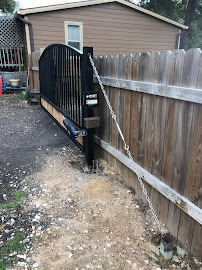Chain link fence gates are indispensable for security, convenience, and property aesthetics. However, wear and tear can cause various issues, leading to the need for timely repairs. Whether you’re dealing with a sagging gate, loose hinges, or damaged mesh, repairing your chain link fence gate can save you time and money. Here’s how you can do it efficiently.
Understanding the Anatomy of a Chain Link Fence Gate
A chain link fence gate consists of several key components:
- Frame: Provides the structural foundation.
- Hinges: Allow the gate to swing open and close.
- Chain Link Mesh: The protective layer that maintains security.
- Latch Mechanism: Ensures the gate stays securely closed.
Recognizing these components helps pinpoint the exact issue and determine the necessary repair steps.
Common Issues in Chain Link Fence Gates
Sagging: Often caused by loose hinges or a weakened frame, sagging gates are difficult to open and close.
Loose Hinges: Over time, hinges may become detached or unstable due to frequent use or rust.
Damaged Chain Link Mesh: Holes or tears in the mesh reduce security and aesthetic appeal.
Misalignment: A misaligned gate can result from ground shifts or improper installation.
Spotting these issues early ensures easier and cost-effective repairs.
Gathering the Right Tools for the Job
Before starting, gather these essential tools:
- Wrench or screwdriver (depending on hinge type)
- Replacement hinges or mesh (if needed)
- Measuring tape
- Wire cutters and pliers
- Level for alignment
- Heavy-duty gloves for safety
Step-by-Step Guide: How to Repair a Chain Link Fence Gate
Preparing for the Repair
- Inspect the gate thoroughly to identify all problem areas.
- Clear the workspace to ensure easy access to the gate.
Tightening Loose Hinges
- Remove the hinge bolts and inspect them for damage.
- Replace worn-out bolts if necessary and tighten them securely.
- Use a level to ensure the gate hangs straight.
Fixing a Sagging Gate
- Check for frame warping or loose connections.
- Adjust the hinges or replace them if necessary.
- Add diagonal tension rods for additional support.
Replacing Damaged Chain Link Mesh
- Use wire cutters to remove the damaged section of the mesh.
- Attach the new mesh using pliers, ensuring it is taut and securely fastened.
Aligning and Reinforcing the Frame
- Measure the gate’s dimensions to check for misalignment.
- Adjust the frame connections and reinforce with braces or welds if required.
Pro Tips for a Long-Lasting Repair
- Use Rust-Resistant Materials: Opt for galvanized hinges and mesh to prevent corrosion.
- Regular Maintenance: Periodically check for loose bolts, sagging, and rust.
- Protective Coating: Apply a protective finish to the gate frame to prolong its lifespan.
When to Call a Professional
While DIY repairs can address most issues, consider hiring a professional if:
- The gate requires welding or advanced structural adjustments.
- The damage involves large sections of the fence.
- You’re uncertain about the repair process.
FAQs
What tools do I need for repairing a fence gate?
Essential tools include wrenches, wire cutters, pliers, and a level.
How do I fix a sagging fence gate?
Tighten hinges, replace damaged ones, and reinforce the frame with tension rods.
Can I replace the chain link mesh myself?
Yes, with the right tools and proper measurements, it’s a manageable task.
How much does it cost to repair a chain link gate?
Costs vary based on materials and labor, but DIY repairs are generally budget-friendly.
What causes a fence gate to sag?
Sagging results from loose hinges, frame warping, or improper installation.
How can I prevent future damage to my gate?
Perform regular maintenance and use rust-resistant materials.
Conclusion
Repairing a chain link fence gate may seem daunting, but with the right tools, preparation, and steps, it’s entirely achievable. Whether you’re fixing a sagging gate, replacing mesh, or reinforcing the frame, these repairs can restore functionality and aesthetics to your property. Don’t forget to perform regular maintenance for lasting results.

